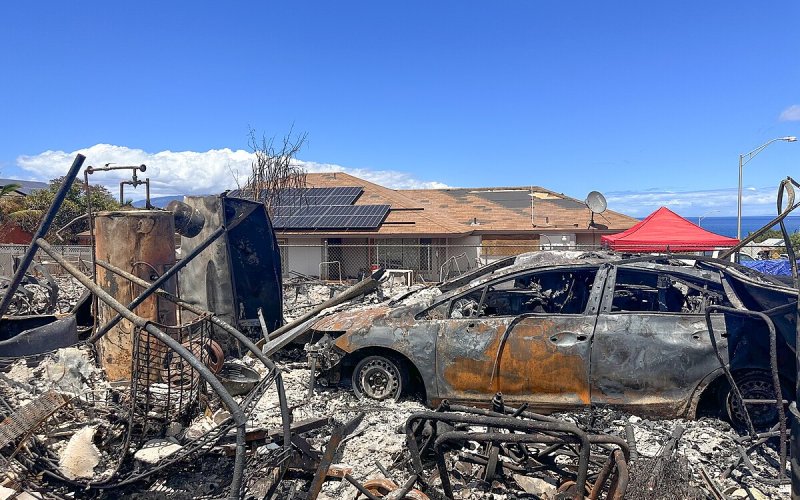CEHC Disaster Scientist Explores Relocation Decisions Following California and Hawaii Wildfires

By J.T. Stone
ALBANY, N.Y. (Oct. 19, 2023) — The recent wildfires in California and the Hawaiian island of Maui highlight the growing threat of extreme weather events to communities across the country. They also reveal how traumatic the decision-making process to relocate can be for survivors whose homes were destroyed.
In August, over 2,200 buildings in Maui were damaged or destroyed, 86 percent of them residential, according to data from the University of Hawaii's Pacific Disaster Center and the Federal Emergency Management Agency. Lahaina, a tourist town in northwestern Maui, experienced the most damage, with some estimates reporting over 80 percent of the city was destroyed.
Alex Greer, an associate professor at the College of Emergency Preparedness, Homeland Security and Cybersecurity (CEHC), has spent the past decade studying hazard adjustments and relocation decisions in the wake of weather and climate disasters. He said there are many reasons people choose to rebuild their home in the same place where a disaster occurred, including place attachment — the emotional and functional ties people have with where they live.
Last year, Greer received $299,825 from the National Science Foundation (NSF) to study place attachment and how it affects people's relocation decisions. The two-year study started by looking at the circumstances of California wildfire victims and now, after receiving an additional $59,939 from NSF last month, Greer is expanding the study to also include Maui residents.

“We were really fascinated with how the California wildfire victims were thinking about place and its impact on their decision to rebuild,” Greer said. “We will now apply some of the same research practices to Maui residents.”
Greer is collaborating with the University of Hawaii on the study to help ensure all data is collected in a culturally sensitive way. The fieldwork will utilize photovoice, a qualitative research method in which participants take photographs related to a specific topic to then reflect on the reasons and emotions that guided their chosen images.
In the case of Maui, Greer said his team will provide residents with cameras to take 28 photos around their home and community to capture the effects of the fire and their recovery effort. These photos will then be used in face-to-face interviews as prompts to discuss different aspects of the relocation decision process and the community recovery effort.
“When you study how people respond to disasters, it’s important to be humble and understand that you don’t know the full extent of what survivors are going through and you likely never will,” Greer said. “We let the survivors shape our research and tell us what would be beneficial to learn about.”
The Decision-Making Process
There are many factors survivors must consider when making relocation decisions, Greer said. This includes accessible cash, what insurance and government assistance are available to them, which mitigation efforts they are considering, and their historical and cultural ties to place.
A major issue survivors face is having inadequate insurance that does not cover the total cost of rebuilding. Likewise, insurance companies often request itemized lists of all lost belongings, from furniture to kitchen utensils, along with a web link that shows the object’s current cost — which may be significantly less than what it was purchased for. Along with being tedious and time-consuming, this process is often emotionally straining and further traumatizing to survivors.
“A lot of people think about residential decision-making as a choice — do I rebuild or not — but what we’ve found is it’s a decision you make over and over again,” Greer said. “People may decide to rebuild in their community because they want to be with people who understand what they went through, but then they hit roadblocks like not having adequate insurance or government aid and then ultimately decide to move.”
Cultural Considerations
Although Hawaii and California have both experienced devastating wildfires, there are important cultural differences the study will consider. Greer anticipates cultural heritage playing a bigger role in the relocation decisions of Native Hawaiians — descendants of the original Hawaiian population when the land was annexed as a U.S. territory in 1898.
In the wake of the Maui fires, there have been reports of residents receiving unsolicited offers from off-island real estate investors to buy their land, putting pressure on them to sell their property, whether or not their home was damaged in the fires.
“Having your home destroyed in a disaster is an incredibly traumatic experience and is not the time you want to be making big life decisions like moving,” Greer said. “Our research can help people make safer decisions and improve their livelihoods when disasters like these occur.”
In addition to working with partners in Hawaii, Greer plans to take several University at Albany undergraduate students to Maui next summer to help conduct field research.




